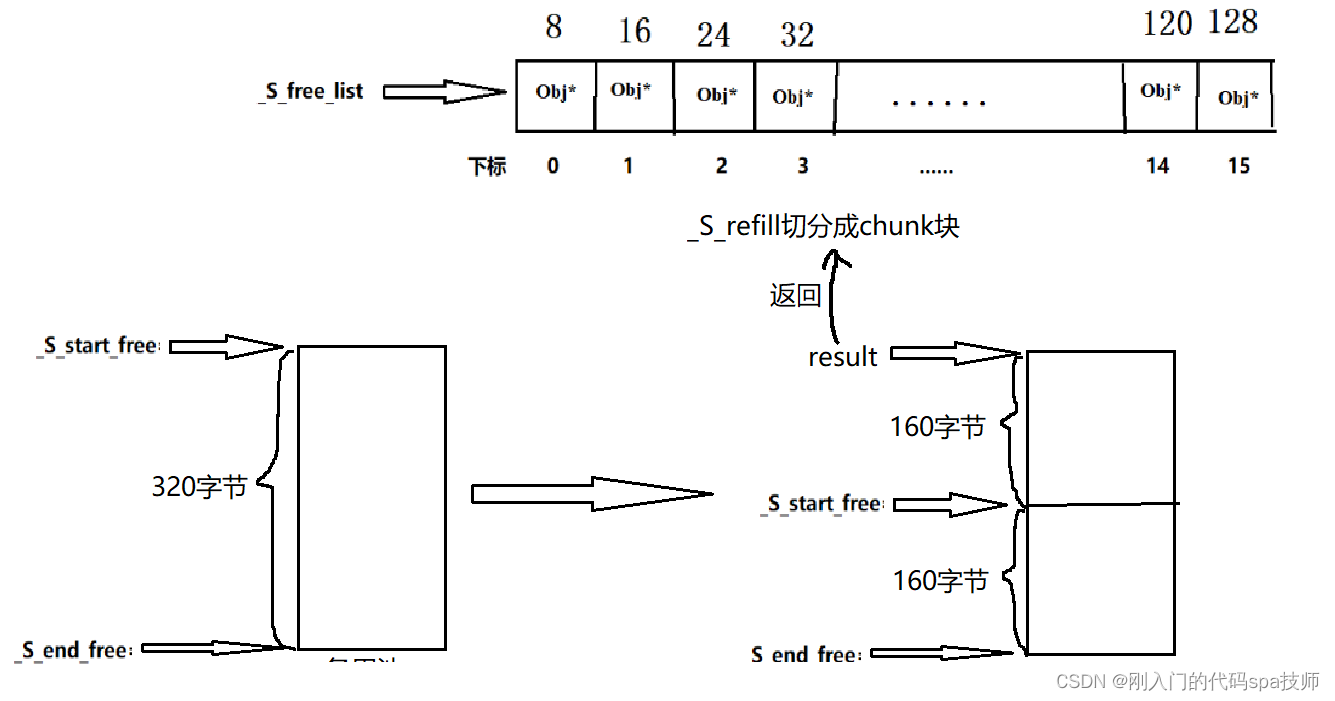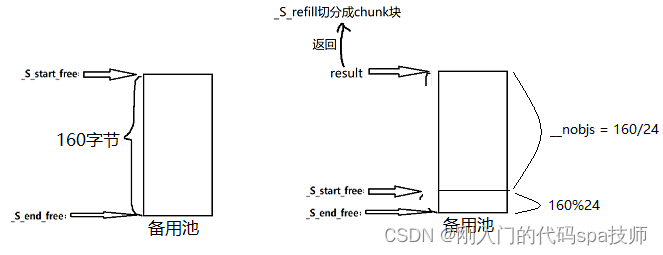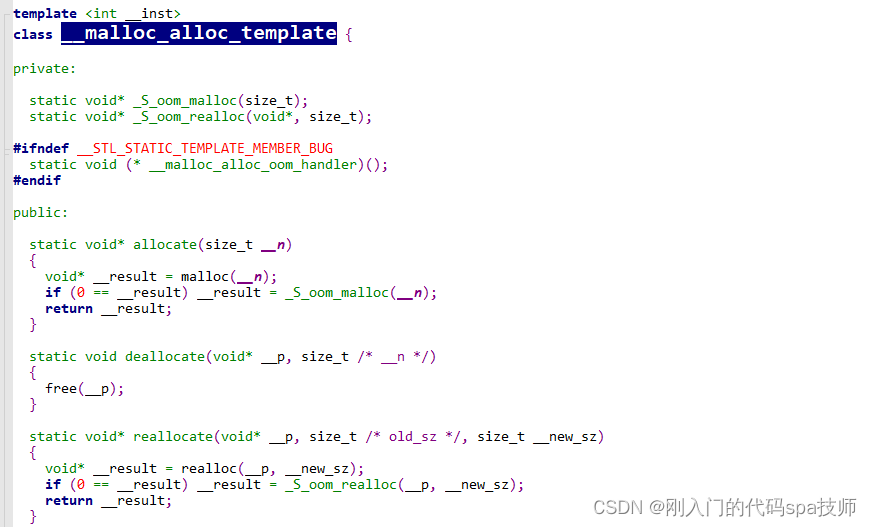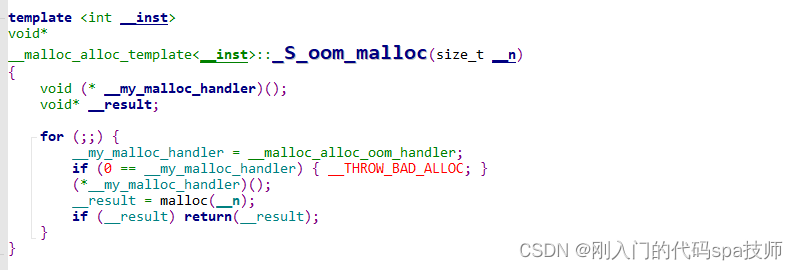剖析SGI STL空间配置器(核心设计:_S_chunk_alloc函数)
_S_chunk_alloc函数是chunk内存块的内存源头。当申请某个自由链表结点下的chunk块不足时,就会调用_S_refill函数来补充chunk块,而填充内存的来源,就是通过_S_chunk_alloc函数申请的。
_S_chunk_alloc函数的设计可以说是二级空间配置器最精妙的设计了。来看它的定义:
template <bool __threads, int __inst>
char*
__default_alloc_template<__threads, __inst>::_S_chunk_alloc(size_t __size,
int& __nobjs)
{
char* __result;
size_t __total_bytes = __size * __nobjs;
size_t __bytes_left = _S_end_free - _S_start_free;
if (__bytes_left >= __total_bytes) {
__result = _S_start_free;
_S_start_free += __total_bytes;
return(__result);
} else if (__bytes_left >= __size) {
__nobjs = (int)(__bytes_left/__size);
__total_bytes = __size * __nobjs;
__result = _S_start_free;
_S_start_free += __total_bytes;
return(__result);
} else {
size_t __bytes_to_get =
2 * __total_bytes + _S_round_up(_S_heap_size >> 4);
// Try to make use of the left-over piece.
if (__bytes_left > 0) {
_Obj* __STL_VOLATILE* __my_free_list =
_S_free_list + _S_freelist_index(__bytes_left);
((_Obj*)_S_start_free) -> _M_free_list_link = *__my_free_list;
*__my_free_list = (_Obj*)_S_start_free;
}
_S_start_free = (char*)malloc(__bytes_to_get);
if (0 == _S_start_free) {
size_t __i;
_Obj* __STL_VOLATILE* __my_free_list;
_Obj* __p;
// Try to make do with what we have. That can't
// hurt. We do not try smaller requests, since that tends
// to result in disaster on multi-process machines.
for (__i = __size;
__i <= (size_t) _MAX_BYTES;
__i += (size_t) _ALIGN) {
__my_free_list = _S_free_list + _S_freelist_index(__i);
__p = *__my_free_list;
if (0 != __p) {
*__my_free_list = __p -> _M_free_list_link;
_S_start_free = (char*)__p;
_S_end_free = _S_start_free + __i;
return(_S_chunk_alloc(__size, __nobjs));
// Any leftover piece will eventually make it to the
// right free list.
}
}
_S_end_free = 0; // In case of exception.
_S_start_free = (char*)malloc_alloc::allocate(__bytes_to_get);
// This should either throw an
// exception or remedy the situation. Thus we assume it
// succeeded.
}
_S_heap_size += __bytes_to_get;
_S_end_free = _S_start_free + __bytes_to_get;
return(_S_chunk_alloc(__size, __nobjs));
}
}
_S_chunk_alloc函数的参数分别是申请内存chunk块的大小__size和需要的块数__nobjs。
首先做的就是计算申请内存块的总大小:size_t __total_bytes = __size * __nobjs;。
size_t __bytes_left = _S_end_free - _S_start_free; 是计算备用池的大小。备用池就是一块完整的、没有被切成chunk块的一块内存空间,_S_start_free和_S_end_free 维护的是这块内存的起始地址和末尾地址。
下面逐个条件对这个函数进行分析:
备用池满足20个块的申请

__bytes_left >= __total_bytes 条件为真,说明备用池已有的空间满足申请内存的大小,这样我们就可以直接把备用池的起始地址返回给__S_refill函数使用,在把_S_start_free维护的备用池做相应的调整就好。
比如我们要申请chunk块大小为8,块数为20的内存块也就是160字节,而我们的备用池内存的大小_S_end_free - _S_start_free 有320字节,我们只需要保存_S_start_free的值返回,在把_S_start_free偏移160个字节即可完成内存申请。过程如下图:

备用池不够20块,但至少满足1块

备用池虽然不满足默认申请的20块,但大于一块的情况下,_S_chunk_alloc函数会把备用池能分的最大块数给分配出去,修改引用传进来的__nobjs,然后再调整维护备用池的_S_start_free指针即可。
假设备用池还有160字节大小的内存,_S_refill函数需要24字节大小的chunk块,大体步骤如下图:

备用池不足一块(核心设计)
else {
size_t __bytes_to_get =
2 * __total_bytes + _S_round_up(_S_heap_size >> 4);
if (__bytes_left > 0) {
_Obj* __STL_VOLATILE* __my_free_list =
_S_free_list + _S_freelist_index(__bytes_left);
((_Obj*)_S_start_free) -> _M_free_list_link = *__my_free_list;
*__my_free_list = (_Obj*)_S_start_free;
}
_S_start_free = (char*)malloc(__bytes_to_get);
if (0 == _S_start_free) {
size_t __i;
_Obj* __STL_VOLATILE* __my_free_list;
_Obj* __p;
for (__i = __size;
__i <= (size_t) _MAX_BYTES;
__i += (size_t) _ALIGN) {
__my_free_list = _S_free_list + _S_freelist_index(__i);
__p = *__my_free_list;
if (0 != __p) {
*__my_free_list = __p -> _M_free_list_link;
_S_start_free = (char*)__p;
_S_end_free = _S_start_free + __i;
return(_S_chunk_alloc(__size, __nobjs));
}
}
_S_end_free = 0; // In case of exception.
_S_start_free = (char*)malloc_alloc::allocate(__bytes_to_get);
}
_S_heap_size += __bytes_to_get;
_S_end_free = _S_start_free + __bytes_to_get;
return(_S_chunk_alloc(__size, __nobjs));
}
}
备用池不足以分出一个chunk块时,就需要malloc从堆申请内存了。申请的大小是chunk块的40块加上上次填备用池大小_S_heap_size >>4。
假设_S_chunk_alloc的请求是按下面的顺序调用的:
- 第一次要申请大小为8的chunk块,内存池初始为空,则需要申请
2*8*20 + _S_round_up(_S_heap_size >>4)=320个字节,然后根据上面的分析,会分出去160字节,备用池还有160字节; - 第二次申请24字节的chunk块,分出去160/24*24=144字节,备用池还剩16字节;
- 第三次申请40字节的chunk块,备用池剩的16字节已经不足以分出一个chunk块了,这时就需要申请
2*40*20+_S_round_up(_S_heap_size >>4) = 800 + _S_round_up(20) = 824字节了
可以很容易推出,两次在同一个chunk大小的结点都需要补充备用池的时候,备用池是越申请越大的。
在第三步需要填备用池时,还剩出16字节的内存没有被分出去,_S_chunk_alloc函数并没有丢弃这块内存,而是把这块内存串到了对应大小的自由链表_S_free_list结点下,没有浪费一点内存。
if (__bytes_left > 0) {
_Obj* __STL_VOLATILE* __my_free_list =
_S_free_list + _S_freelist_index(__bytes_left);
((_Obj*)_S_start_free) -> _M_free_list_link = *__my_free_list;
*__my_free_list = (_Obj*)_S_start_free;
}
剩余的内存处理完后,就是malloc从堆申请内存了。如果malloc申请成功,调整_S_start_free,_S_end_free,_S_heap_size的值,递归调用_S_chunk_alloc,就会进入第一个判断条件处理返回结果了。
但malloc是有申请失败的可能的!
malloc失败时,_S_chunk_alloc的处理过程很值得学习。
if (0 == _S_start_free) {
size_t __i;
_Obj* __STL_VOLATILE* __my_free_list;
_Obj* __p;
for (__i = __size;
__i <= (size_t) _MAX_BYTES;
__i += (size_t) _ALIGN) {
__my_free_list = _S_free_list + _S_freelist_index(__i);
__p = *__my_free_list;
if (0 != __p) {
*__my_free_list = __p -> _M_free_list_link;
_S_start_free = (char*)__p;
_S_end_free = _S_start_free + __i;
return(_S_chunk_alloc(__size, __nobjs));
}
}
_S_end_free = 0; // In case of exception.
_S_start_free = (char*)malloc_alloc::allocate(__bytes_to_get);
}
首先会依次遍历存储比该chunk块大的自由链表_S_free_list结点,看有没有比当前chunk块大的空闲chunk块,如果存在:
if (0 != __p) {
*__my_free_list = __p -> _M_free_list_link;
_S_start_free = (char*)__p;
_S_end_free = _S_start_free + __i;
return(_S_chunk_alloc(__size, __nobjs));
}
把_S_start_free 和_S_end_free 指向这块空闲chunk块的起始地址和末尾地址,然后递归调用_S_chunk_alloc,这时候_S_end_free -_S_start_free 的值,是绝对比申请chunk块大小__size大的,就会进入第二个判断条件处理返回结果了。
如果还是没有可用的内存块呢? SGI STL二级空间配置器的异常处理还能挣扎一下!回去调用_S_start_free = (char*)malloc_alloc::allocate(__bytes_to_get);这个函数,我们找到这个函数的定义:


malloc_alloc::allocate首先会再尝试malloc申请,如果还是申请失败,就会调用_S_oom_malloc函数,其定义如下:

_S_oom_malloc函数会定义一个函数指针void (* __my_malloc_handler)();,检查用户有没有事先注册一个释放内存的回调函数。
如果没有注册,则会抛出__THROW_BAD_ALLOC;的异常处理;
如果注册了,就会执行这个函数释放资源,如果释放了资源再malloc申请,就有可能申请成功。
如果注册的函数没有释放资源或释放的资源不足malloc成功,程序就会陷入死循环,直到申请成功为止。























 1204
1204











 被折叠的 条评论
为什么被折叠?
被折叠的 条评论
为什么被折叠?










